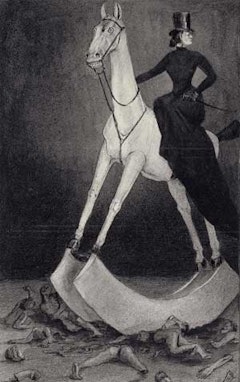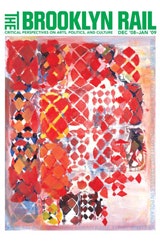ArtSeen
Alfred Kubin: Drawings, 1897 – 1909
NEUE GALERIE NEW YORK | SEPTEMBER 25, 2008 – JANUARY 26, 2009

Alfred Kubin’s oeuvre is based on the artist’s lifelong fascination with the dark sides of the human subconscious. Through spectral fantasies and bizarre dreamscapes rendered in ink, pen, and occasionally tempera on paper, he told of the demons of human existence as embodied in insatiable greed, sadistic lust, fear, torture, and most consistently, death.
While Kubin’s pessimistic worldview was much informed by the writings of Nietzsche and Schopenhauer, it also sprang from personal tragedy. His childhood, spent in Salzburg and Zell am See, Austria, was overshadowed by his mother’s death when he was only ten years old. In 1926, he explained that in fact “the countless corpses and dying people I rendered as an artist are also children of that dreadful day.” Afterward, his youth was troubled and isolated, especially in regard to his complicated relationship with his domineering father, who deemed his dreamy son a failure. At nineteen, Kubin attempted suicide at his mother’s grave, leading to a complete mental and physical collapse.
It was not until 1898, after moving to Munich to pursue art, that Kubin found a release for his emotions as well as a supportive circle of friends. He enrolled in a private drawing class with Ludwig Schmidt-Reutte and in the following year began to study at the Munich Academy of Fine Art. By focusing on Kubin’s formative years, this exhibition provides examples of works that clearly reveal Kubin’s early artistic influences. In the late 1890s, Kubin was introduced to the graphic work of Max Klinger and encountered Goya’s “Disasters of War.” Inspired by these artists’ dramatic chiaroscuro effects, Kubin developed a style that combined pen drawing and washes with a screened spray technique to add texture and depth. Furthermore, the work of Odilon Redon and James Ensor provided ammunition for Kubin’s taste for the grotesque and a latter-day Symbolism, which had much in common with the Belgian Decadent Félicien Rops.
Though still defining his artistic voice in the early 1900s, Kubin began to become successful. By 1902, he was exhibiting at the prestigious Cassirer Gallery in Berlin, and the following year at the Vienna and Berlin Secessions. In 1903, the collector Hans von Weber published a portfolio of his drawings. Kubin also became involved with the Expressionist movement in Munich and would later repeatedly show with the Blaue Reiter group around Wassily Kandinsky. In addition, he illustrated literary works by Edgar Allan Poe, E.T.A. Hoffmann, and Fyodor Dostoevsky. In 1909, he published his own novel, Die Andere Seite (The Other Side), an apocalyptic fantasy set in an oppressive, imaginary country. Franz Kafka, whom Kubin met in Prague in 1911, would later use some of this novel’s motifs in his own work, The Castle.
Though in many ways freely associative, Kubin’s visual work is also significantly influenced by literature and the art of storytelling. In fact, his drawings often seem to contain an underlying narrative, as if each work could serve as a window into a more complex story—and in some ways they do. Fascinating as Kubin’s drawings are if viewed separately, they grow in significance when considered as a whole and in their historical context. As a group, they establish an apocalyptic worldview that might have been regarded as morbidly fantastical for its time, but which soon after would find its realization in the incomprehensible horrors of World Wars I and II. Kubin was not the only artist and intellectual who sensed that civilization’s potential for self-destruction was crystallizing at the turn of the century, but his work does offer one of the most poetic and uninhibited depictions of the human depredations that made what happened possible.
In 1897, two years before the publication of Sigmund Freud’s Die Traumdeutung (The Interpretation of Dreams), the twenty-year-old Kubin gave a drawing to his sister Frederike that included the note: “Life is a dream. Dream happily!” This wish is both aspirational and desperate considering how unhappy Kubin’s personal life in fact was. To Kubin, dreams were a form of escapism, but also the beginning of true nightmares.




